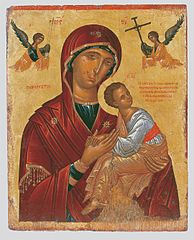Virgin of the Passion
| Virgin of the Passion | |
|---|---|
| Greek: Παναγία του Πάθους, Italian: Vergine della Passione | |
 | |
| Artist | Emmanuel Tzanfournaris |
| Year | 1585-1630 |
| Medium | tempera on wood |
| Movement | Late Cretan School |
| Subject | Virgin and Child |
| Dimensions | 83.3 cm × 66.5 cm (33 in × 26.2 in) |
| Location | Hellenic Institute of Venice, Venice, Italy |
| Owner | Hellenic Institute of Venice |
The Virgin of the Passion is a famous rendition of the Madonna and Child by Greek painter Emmanuel Tzanfournaris. He was born in Corfu to the painter Georgios Tzanfournaris. By age twenty-nine Emmanuel moved to Venice. Emmanuel's teacher was painter Thomas Bathas. He met him on the island Corfu. Bathas left Emmanuel a sizable fortune in his will. Both painters created a famous version of the Virgin and Child. The Bathas version is called Virgin Nikopoios.[1][2]
The Panagia and Child have been painted countless times by Greek and Italian artists. Legend has it that Luke was the first to paint a portrait of the two figures. The painting style has roots in Greek-Italian Byzantine art. The Tzanfournaris version is part of the collection of the Hellenic Institute of Venice Museum.[3]
Description
The painting is egg tempera and gold leaf on wood panel. The dimensions are 83.3 cm (33 in ) x 66.5 cm (26.2 in) it was completed between 1585-1630. The painting features the Virgin holding the infant Jesus. The icon depicts the Virgin Mary up to the waist holding Christ with her left hand. The toddler looks away. He leans towards her and rests both hands on his mother's right hand, embracing his mother.[1]
The artist chooses a superlative tone of brown to exhibit the Virgin's attire. The clothing is presented with lines, striations, curves, and clear folds of fabric. The brown color shading and tones blend perfectly. There is clear detail in the face and hands of the virgin. The toddler wears his traditional orange attire. The Virgin's clothing is also decorated with a similar color. The gold background was well preserved. Two angels are at the top, the angel to our right carries the cross of passion. The second angel to our left carries a sphere, jar, and blanket.
The position of the Panagia and Child is the traditional Hodegetria (Our Lady of the Way) in Italian La Madonna Odigitria. There are three versions of the position. In the first style, Jesus looks away from the Virgin, in the second type, Jesus looks at the audience. In the third Version, Jesus looks at the Virgin Mary. Although the subject is similar among artists of the style each painting has its own unique character and identity.
Gallery
References
- ^ a b Hatzidakis, Manolis; Drakopoulou, Evgenia (1997). Έλληνες Ζωγράφοι μετά την Άλωση (1450-1830). Τόμος 2: Καβαλλάρος - Ψαθόπουλος [Greek Painters after the Fall of Constantinople (1450-1830). Volume 2: Kavallaros - Psathopoulos]. Athens: Center for Modern Greek Studies, National Research Foundation. pp. 429–430. ISBN 960-7916-00-X.
- ^ Eugenia Drakopoulou (November 12, 2021). "Tzanfournaris Emmanouil (Manos)". Institute for Neohellenic Research. Retrieved November 12, 2021.
- ^ Staff Writers (November 12, 2021). "Greek Art Catalogue". Digitized Archive of the Hellenic Institute of Venice. Retrieved November 12, 2021.


